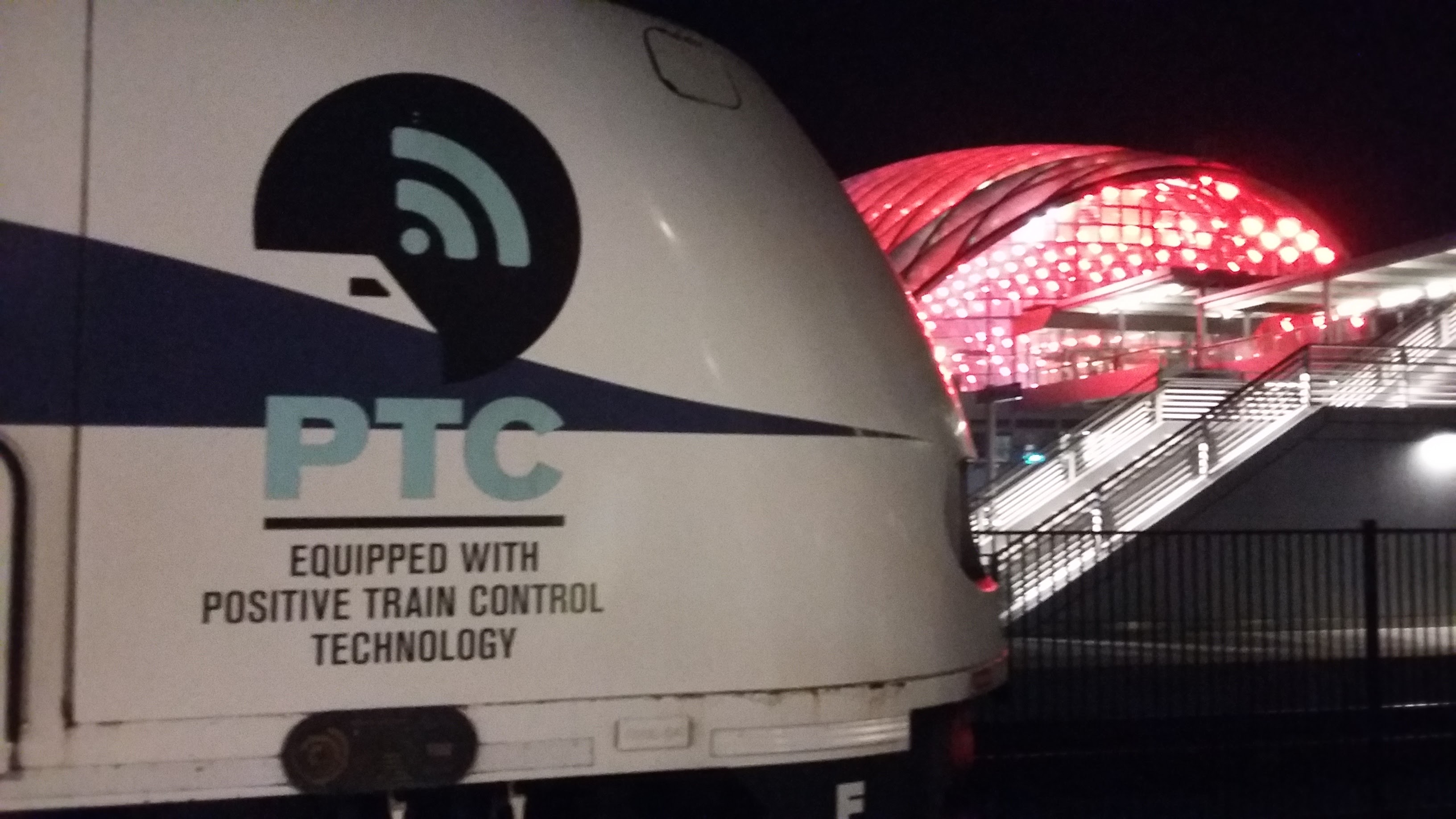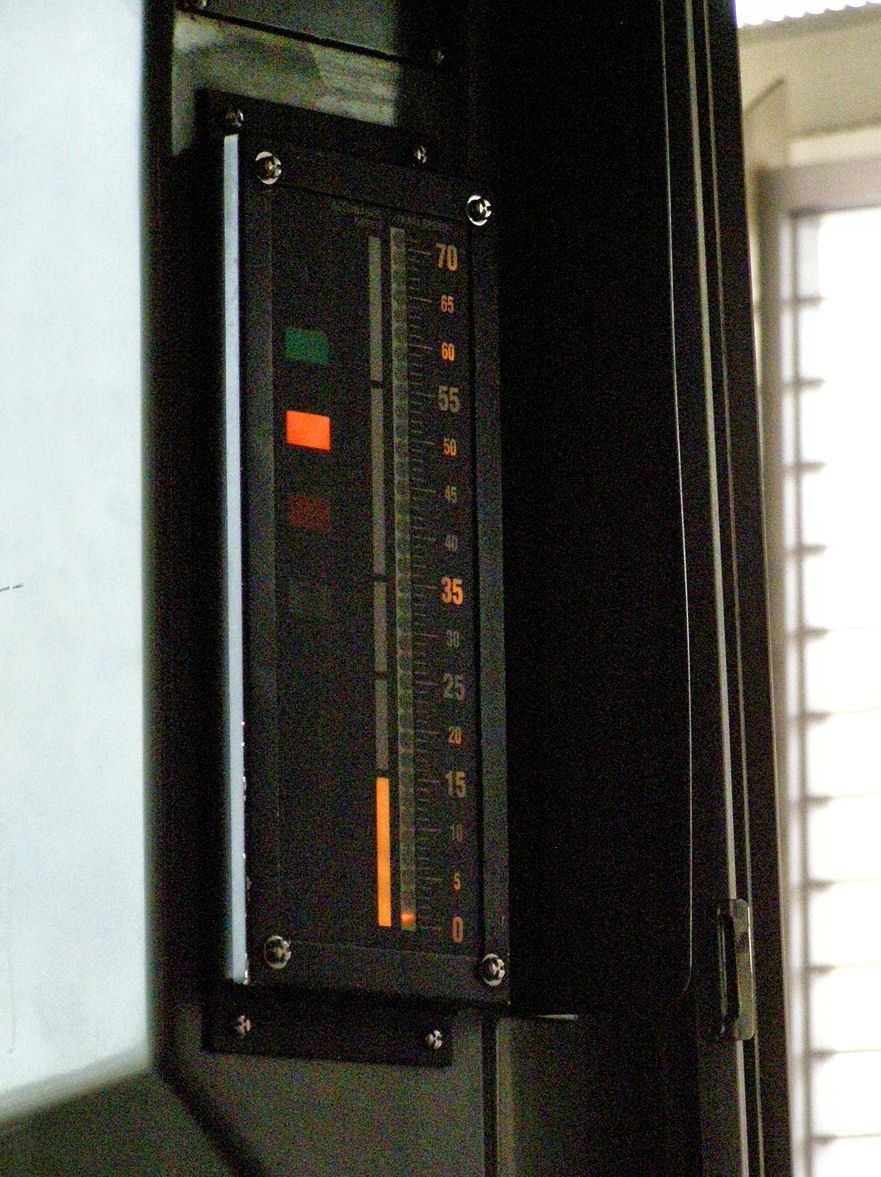|
ACSES
Advanced Civil Speed Enforcement System (ACSES) is a positive train control cab signaling system developed by Alstom. The system is designed to prevent train-to-train collisions, protect against overspeed, and protect work crews with temporary speed restrictions. The information about permanent and temporary speed restrictions is transmitted to the train by transponders (Balises) lying in the track, coded track circuits and digital radio. It was installed beginning in 2000 on all of Amtrak's Northeast Corridor (except MTA territory) between Washington and Boston, and has been fully active since December 2015, a few months after the 2015 Philadelphia train derailment which it would have prevented. General system design ACSES provides railway trains with positive enforcement of "civil" speed restrictions (those based on the physical characteristics of the line). The on-board components keep track of a train's position and continuously calculates a maximum safe braking curve ... [...More Info...] [...Related Items...] OR: [Wikipedia] [Google] [Baidu] |
Positive Train Control
Positive train control (PTC) is a family of automatic train protection systems deployed in the United States. Most of the United States' national rail network mileage has a form of PTC. These systems are generally designed to check that trains are moving safely and to stop them when they are not. A simplistic form of train traffic governance is ''negative'' train control, where trains must stop when issued a stop order and can move in the absence of such. An example of negative train control is Indusi. In contrast, ''positive'' train control restricts the train movement to an explicit allowance; movement is halted upon invalidation. A train operating under PTC receives a ''movement authority'' containing information about its location and where it is allowed to safely travel. As of 2019, the U.S. freight rail industry trade organization AAR claimed that the nation's largest freight railroads were operating PTC across 83.2 percent of the required route miles. The American Railwa ... [...More Info...] [...Related Items...] OR: [Wikipedia] [Google] [Baidu] |
Cab Signalling
Cab signaling is a railway safety system that communicates track status and condition information to the cab, crew compartment or driver's compartment of a locomotive, railcar or multiple unit. The information is continually updated giving an easy to read display to the train driver or engine driver. The simplest systems display the trackside signal, while more sophisticated systems also display allowable speed, location of nearby trains, and dynamic information about the track ahead. Cab signals can also be part of a more comprehensive train protection system that can automatically apply the brakes stopping the train if the operator does not respond appropriately to a dangerous condition. Overview The main purpose of a signal system is to enforce a safe separation between trains and to stop or slow trains in advance of a restrictive situation. The cab signal system is an improvement over the wayside signal system, where visual signals beside or above the right-of-way gov ... [...More Info...] [...Related Items...] OR: [Wikipedia] [Google] [Baidu] |
2015 Philadelphia Train Derailment
On May 12, 2015, an Amtrak ''Northeast Regional'' train from Washington, D.C. bound for New York City derailed and wrecked on the Northeast Corridor near the Kensington neighborhood of Philadelphia, Pennsylvania. Of 238 passengers and 5 crew on board, 8 were killed and over 200 injured, 11 critically. The train was traveling at in a zone of curved tracks when it derailed. Some of the passengers had to be extricated from the wrecked cars. Many of the passengers and local residents helped first responders during the rescue operation. Five local hospitals treated the injured. The derailment disrupted train service for several days. The National Transportation Safety Board determined that the derailment was caused by the train's engineer (driver) becoming distracted by other radio transmissions and losing Situation awareness, situational awareness, and said that it would have been prevented by positive train control, a computerized speed-limiting system that was operational elsewh ... [...More Info...] [...Related Items...] OR: [Wikipedia] [Google] [Baidu] |
Northeast Corridor
The Northeast Corridor (NEC) is an electrified railroad line in the Northeast megalopolis of the United States. Owned primarily by Amtrak, it runs from Boston through Providence, New Haven, Stamford, New York City, Philadelphia, Wilmington, and Baltimore to Washington, D.C. The NEC closely parallels Interstate 95 for most of its length, and is the busiest passenger rail line in the United States both by ridership and by service frequency as of 2013. The NEC carries more than 2,200 trains daily. The corridor is used by many Amtrak trains, including the high-speed Acela, intercity trains and several long-distance trains. Most of the corridor also has frequent commuter rail service, operated by the MBTA, Shore Line East, Hartford Line, Metro-North Railroad, Long Island Rail Road, New Jersey Transit, SEPTA and MARC. While large through freights have not run on the NEC since the early 1980s, several companies continue to run smaller local freights over some select few sections ... [...More Info...] [...Related Items...] OR: [Wikipedia] [Google] [Baidu] |
Balise
A balise is an electronic beacon or transponder placed between the rails of a railway as part of an automatic train protection (ATP) system. The French word ''balise'' is used to distinguish these beacons from other kinds of beacons. Balises are used in the KVB signalling system installed on main lines of the French railway network, other than the high-speed Lignes à Grande Vitesse. Balises constitute an integral part of the European Train Control System, where they serve as "beacons" giving the exact location of a train. The ETCS signalling system is gradually being introduced on railways throughout the European Union. Balises are also used in the Chinese Train Control System versions CTCS-2 and CTCS-3 installed on high-speed rail lines in China, which is based on the European Train Control System. A balise which complies with the European Train Control System specification is called a Eurobalise. Overview A balise typically needs no power source. In response to radi ... [...More Info...] [...Related Items...] OR: [Wikipedia] [Google] [Baidu] |
Balises
A balise is an electronic beacon or transponder placed between the rails of a railway as part of an automatic train protection (ATP) system. The French word ''balise'' is used to distinguish these beacons from other kinds of beacons. Balises are used in the KVB signalling system installed on main lines of the French railway network, other than the high-speed Lignes à Grande Vitesse. Balises constitute an integral part of the European Train Control System, where they serve as "beacons" giving the exact location of a train. The ETCS signalling system is gradually being introduced on railways throughout the European Union. Balises are also used in the Chinese Train Control System versions CTCS-2 and CTCS-3 installed on high-speed rail lines in China, which is based on the European Train Control System. A balise which complies with the European Train Control System specification is called a Eurobalise. Overview A balise typically needs no power source. In response to radi ... [...More Info...] [...Related Items...] OR: [Wikipedia] [Google] [Baidu] |
Digital Radio
Digital radio is the use of digital technology to transmit or receive across the radio spectrum. Digital transmission by radio waves includes digital broadcasting, and especially digital audio radio services. Types In digital broadcasting systems, the analog audio signal is digital audio, digitized, Audio compression (data), compressed using an audio coding format such as AAC+ (MDCT) or MPEG-1 Audio Layer II, MP2, and transmitted using a digital modulation scheme. The aim is to increase the number of radio programs in a given spectrum, to improve the audio quality, to eliminate fading problems in mobile environments, to allow additional datacasting services, and to decrease the transmission power or the number of transmitters required to cover a region. However, analog radio (AM and FM) is still more popular and listening to radio over IP (Internet Protocol) is growing in popularity. In 2012 four digital wireless radio systems are recognized by the International Telecommunicati ... [...More Info...] [...Related Items...] OR: [Wikipedia] [Google] [Baidu] |
Advanced Train Control System
An Advanced Train Control System (ATCS) is a system of railway/railroad equipment designed to ensure safety by monitoring locomotive and train locations, providing analysis and reporting, automating track warrants, detecting blind spot and similar orders. ATCS specifications are published by the Association of American Railroads (AAR), and are designed to document the stated requirements of railway/railroad operational and technical professionals concerning ATCS hardware and software.Association of American Railroads, Washington, DC (2005)"Manual of Standards and Recommended Practices. Section K: Railway Electronics." The basic principle behind ATCS is to provide a cost efficient, safe, modular, train control system with an open architecture. The primary goals of the system are to provide for * compatibility of systems across railroads. This helps to ensure seamless operation. For example, locomotives from one railroad will be able to communicate, via data radio, with dispatch ce ... [...More Info...] [...Related Items...] OR: [Wikipedia] [Google] [Baidu] |
Antenna (radio)
In radio engineering, an antenna or aerial is the interface between radio waves propagating through space and electric currents moving in metal conductors, used with a transmitter or receiver. In transmission, a radio transmitter supplies an electric current to the antenna's terminals, and the antenna radiates the energy from the current as electromagnetic wave In physics, electromagnetic radiation (EMR) consists of waves of the electromagnetic (EM) field, which propagate through space and carry momentum and electromagnetic radiant energy. It includes radio waves, microwaves, infrared, (visib ...s (radio waves). In Receiver (radio), reception, an antenna intercepts some of the power of a radio wave in order to produce an electric current at its terminals, that is applied to a receiver to be Amplifier, amplified. Antennas are essential components of all radio equipment. An antenna is an array of conductor (material), conductors (Driven element, elements), elect ... [...More Info...] [...Related Items...] OR: [Wikipedia] [Google] [Baidu] |
Permanent Way
A railway track (British English and UIC terminology) or railroad track (American English), also known as permanent way or simply track, is the structure on a railway or railroad consisting of the rails, fasteners, railroad ties (sleepers, British English) and ballast (or slab track), plus the underlying subgrade. It enables trains to move by providing a dependable surface for their wheels to roll upon. Early tracks were constructed with wooden or cast iron rails, and wooden or stone sleepers; since the 1870s, rails have almost universally been made from steel. Historical development The first railway in Britain was the Wollaton Wagonway, built in 1603 between Wollaton and Strelley in Nottinghamshire. It used wooden rails and was the first of around 50 wooden-railed tramways built over the next 164 years. These early wooden tramways typically used rails of oak or beech, attached to wooden sleepers with iron or wooden nails. Gravel or small stones were packed around the s ... [...More Info...] [...Related Items...] OR: [Wikipedia] [Google] [Baidu] |
Backward Compatible
Backward compatibility (sometimes known as backwards compatibility) is a property of an operating system, product, or technology that allows for interoperability with an older legacy system, or with input designed for such a system, especially in telecommunications and computing. Modifying a system in a way that does not allow backward compatibility is sometimes called " breaking" backward compatibility. A complementary concept is forward compatibility. A design that is forward-compatible usually has a roadmap for compatibility with future standards and products. A related term from programming jargon is hysterical reasons or hysterical raisins (near-homophones for "historical reasons"), as the purpose of some software features may be solely to support older hardware or software versions. Usage In hardware A simple example of both backward and forward compatibility is the introduction of FM radio in stereo. FM radio was initially mono, with only one audio channel represented ... [...More Info...] [...Related Items...] OR: [Wikipedia] [Google] [Baidu] |






